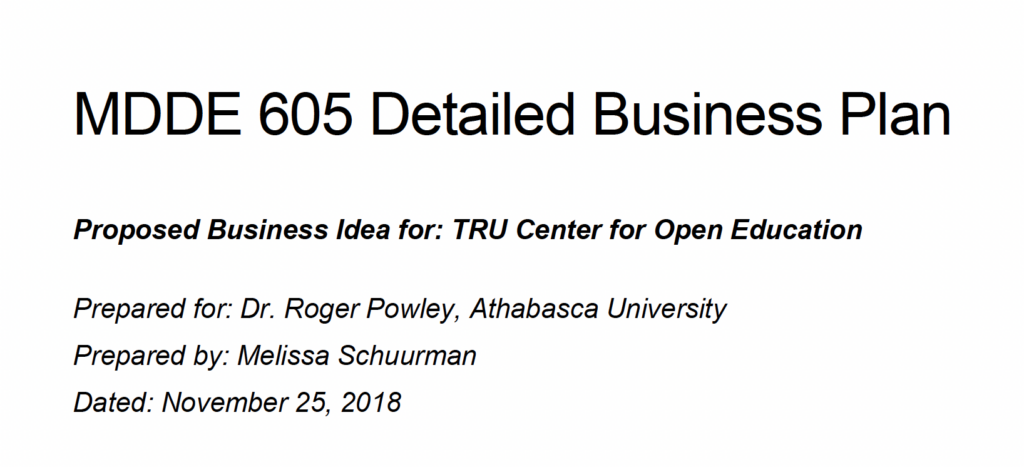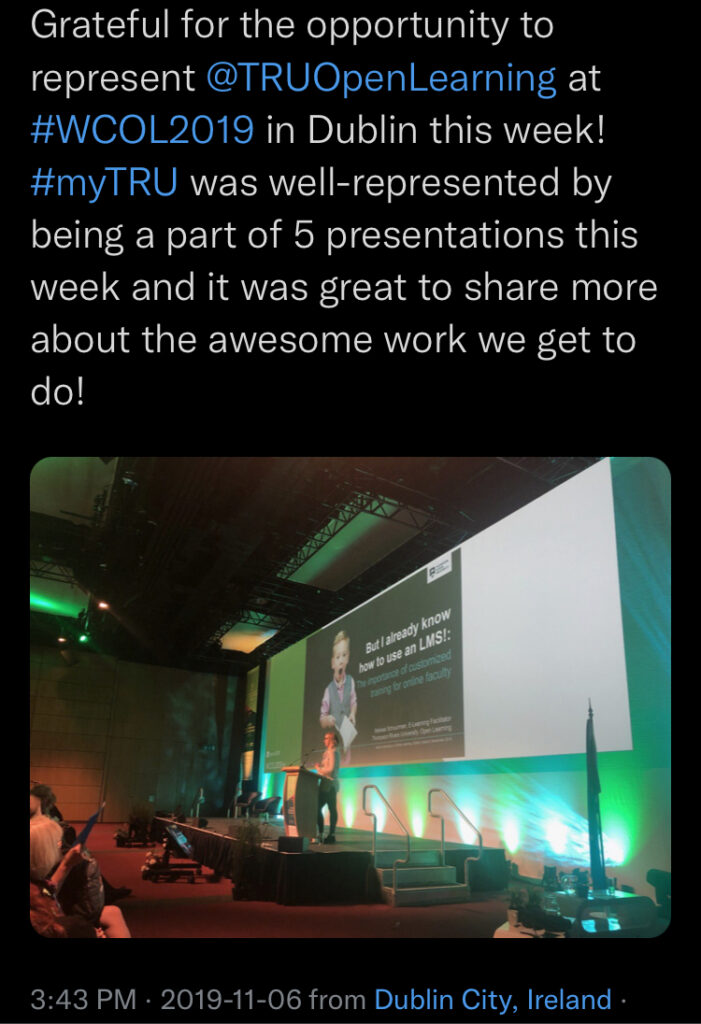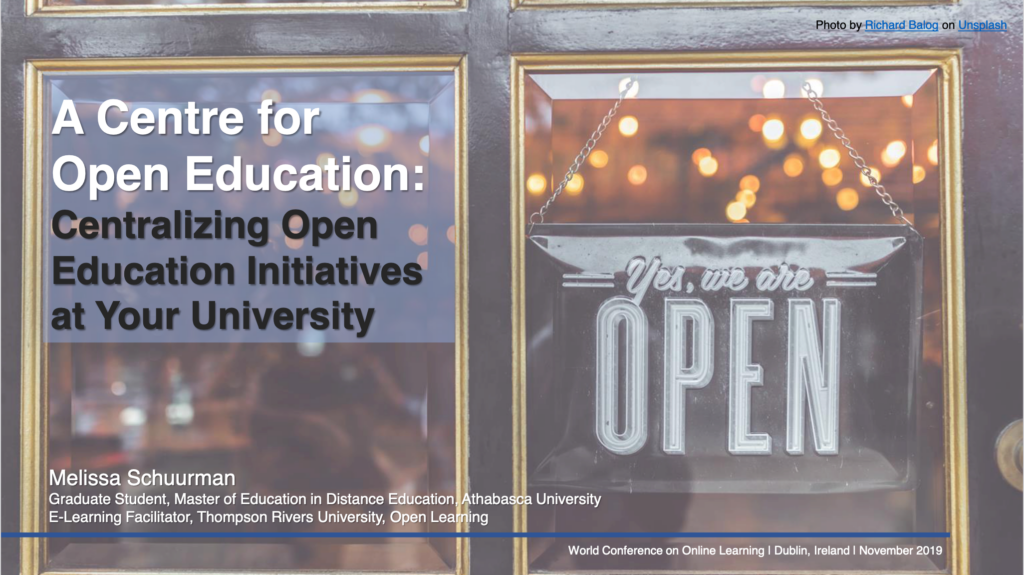Business Plan
The second artefact in this portfolio is the final assignment from MDDE 605: Planning and Management in Distance Education and Training, the fifth course I completed as part of my Masters program. This assignment was final piece of a three-part project for the course where we created a proposal for a centralized distance education unit within an organization. The first piece was to conduct a business analysis (assignment 1), then a strategic plan (assignment 2), and then compile everything into a business plan (assignment 3). For my project, I chose to create a centralized unit dedicated to running and support open education initiatives at a post-secondary institution. I used the university I am employed at, Thompson Rivers University (TRU), for the unit to be established in, as TRU has an online and distance education unit and is heavily involved in OER initiatives in BC and around the world.
Why this artefact?
One of my learning goals when I started this program was to have a more well-rounded view and understanding of how the different aspects of a distance education unit worked together. When I looked at the requirements for this project, I knew right away that this would help better my understanding of what it would require to establish and set up a unit like this at an institution. It was also an opportunity to utilize my previous educational experience in business and work experience in research and analysis, and combine those skills with what I was learning in an applicable project.
This artefact demonstrates elements of the following MEd program competencies which are noted in parenthesis in my reflection:
- 1. Problem Solving, Analysis & Reflective Decision Making
- 1.12 Reflectively analyze and apply learning experiences to current and future situations
- 1.13 Reflectively transfer formal learning to professional/workplace/personal contexts
- 4. Communication & Interpersonal Skills
- 4.1 Write clearly and in a style appropriate to purpose (e.g. assignments, reflective essays or journals, published documents, blog posts, eportfolios, and theses)
- 4.3 Justify and defend your ideas orally and in writing in meetings, forums, seminars, exams and other contexts
- 4.7 Demonstrate effective design, delivery and critical evaluation of presentations, online forums, webinars, or seminars
- 6. Management, Organization and Leadership
- 6.1 Analyze the current and future climate of open, digital and distance education, and formulate strategies to respond to that climate
- 6.5 Outline and critically compare the relative costs of appropriate technology-based communications methods in open and digital education and ensure that the organization is receiving a good return on investment
Reflections on Artefact 2

I remember when I first looked at the project for MDDE 605, I was excited for the opportunity it presented. Not only was this an opportunity to learn how to create a business plan, but it was also an opportunity to do something relevant to my work and create something that could be utilized in a real-life application. I had some previous experience with conducting market analysis in both school and work, but this was an opportunity to go through all the steps of creating a credible business plan (1.12). I’ve found that the opportunities I’ve had in my educational experience where I can apply what I’m learning are the opportunities where I thrive the most, and feel the most engaged with the learning experience.
This assignment was the final part of the project for this course, the business plan. The previous two assignments were a business analysis and a strategic plan that were used to help create the final product of the business plan. We had the opportunity to learn about and go through the business planning process, which was a new experience for me. The business plan required identifying a business structure which flowed from the strategic plan completed in Assignment 2, a financial plan, a balanced scorecard, and a summary of the resources required to implement the business plan. A business plan template was provided and was used in writing the business plan (4.1), which was helpful because I was a little out of practice when it came to business writing. I had done a lot of that type of writing in my undergraduate degree, but this assignment was a good refresher as I had become more accustomed to academic writing due to the work I do and being enrolled in the master’s program.
As stated previously, I chose to create a centralized unit dedicated to running and support open education initiatives at a post-secondary institution for my project. I used the university I am employed at, TRU, as the institution to present this opportunity to, largely because I have of the institution and as TRU has an online and distance education unit and is heavily involved in OER initiatives in BC and around the world (1.13). The process of developing a detailed business plan for the Center for Open Education begin with the initial business analysis and strategic planning process. These two phases included identifying current resources and practices at TRU, a competitive analysis, environmental analysis, a needs/gap analysis and establishing a vision and mission statement for the Center (4.3, 6.1). The result of these phases contributed to the development of a sound business plan that could help TRU establish the only known Center for Open Education. As with other institutions, TRU has open educational initiatives running out of various units and departments. The idea to centralize these efforts is new and TRU was chosen as it was in a unique position to be the first institution to establish such a unit.
The most challenging aspect of this assignment was creating the financial plan, and estimating the projected revenue and expenses for such an operation (6.5). This was not something I had experience with previously, even in my business degree, so I had to rely heavily on the support of my instructor, course resources and other budgeting resources I had access to. I chose to base my plan on a budget and resources similar to TRU’s Center for Learning and Teaching (CELT), as the structure of the unit would be similar in nature, specifically when it came to personnel resources. I will admit, this part of the project came with a lot of frustration, because I was constantly going back and forth with my instructor revising and adjusting the budget so that it was as realistic and practical as it could be for a hypothetical situation. I’ve never been strong when it came to finances, I learned that very quickly when I took my introductory accounting and finance courses in my BBA, so I knew this would be the area where I struggled the most, which was a humbling reminder that I am still learning and probably will continue to be for the rest of my life.
I also had the opportunity to share and present this business plan to external parties (4.7). My colleague at Kwantlen Polytechnic University (KPU), Dr. Rajiv Jhangiani, requested a copy of my business plan to use as reference for a plan he was putting together for KPU. I had reached out to him when I first started the project, to get his feedback and ideas on how an institute could generate revenue from producing OERs, so he was eager to see the final result of my work as he thought it could be useful in the work he was doing. He was able to use components of the business plan in his proposal for a new OER initiative at KPU, where he now has some dedicated personnel that focus primarily on OER support for the institution, which previously something he and a handful of others did in conjunction with their primary duties. I was also able to present this business plan at the 28th ICDE World Conference on Online Learning, held in Dublin, Ireland in November 2019.

It was one of two presentations I gave at the conference, and the slides from the presentation are available here. It was a great opportunity because it allowed me to connect with many other individuals from around the world who have similar ideas, but also to connect with a number of faculty from Athabasca University who were also attending the conference. The presentation was well received and I had the opportunity to conclude it by asking attendees if they thought there was an opportunity to centralize open education, which had some people thinking about what a central open education unit would look like.
Unfortunately, this business plan was not used by my institution (at least, not yet). However, aspects of it were used elsewhere, and the idea of it started a conversation that some people may not have thought of before. Conversations around the realization that there is a lot of duplication happening because departments are working on their own projects and not always communicating and/or collaborating. The idea of centralizing the work being done has the potential to reduce costs and workload, and remove duplication in work being done. Looking back on it, I take that as a win, because it sparked an idea. Where that idea goes, I’m not sure, but I’m thankful that I have been able to be part of where that idea goes into potentially becoming a reality somewhere down the line.


Susan Moisey
This was certainly a good choice for an artefact to reflect upon. You did a good job of identifying the competencies that were attained. Your critical analysis included both things you had struggled with (the financial element) and something that was an important bonus (the conference presentation) associated with the artefact. In the last paragraph where you mention that “it started a conversation that people may not have thought of before” it would be good to expand a bit and include the key parts of this conversation — that would be a stronger conclusion to your analysis and help show the connection between your new learning and your workplace.
Melissa
Thank you Susan, I have expanded on the conversation piece you noted in the last paragraph.